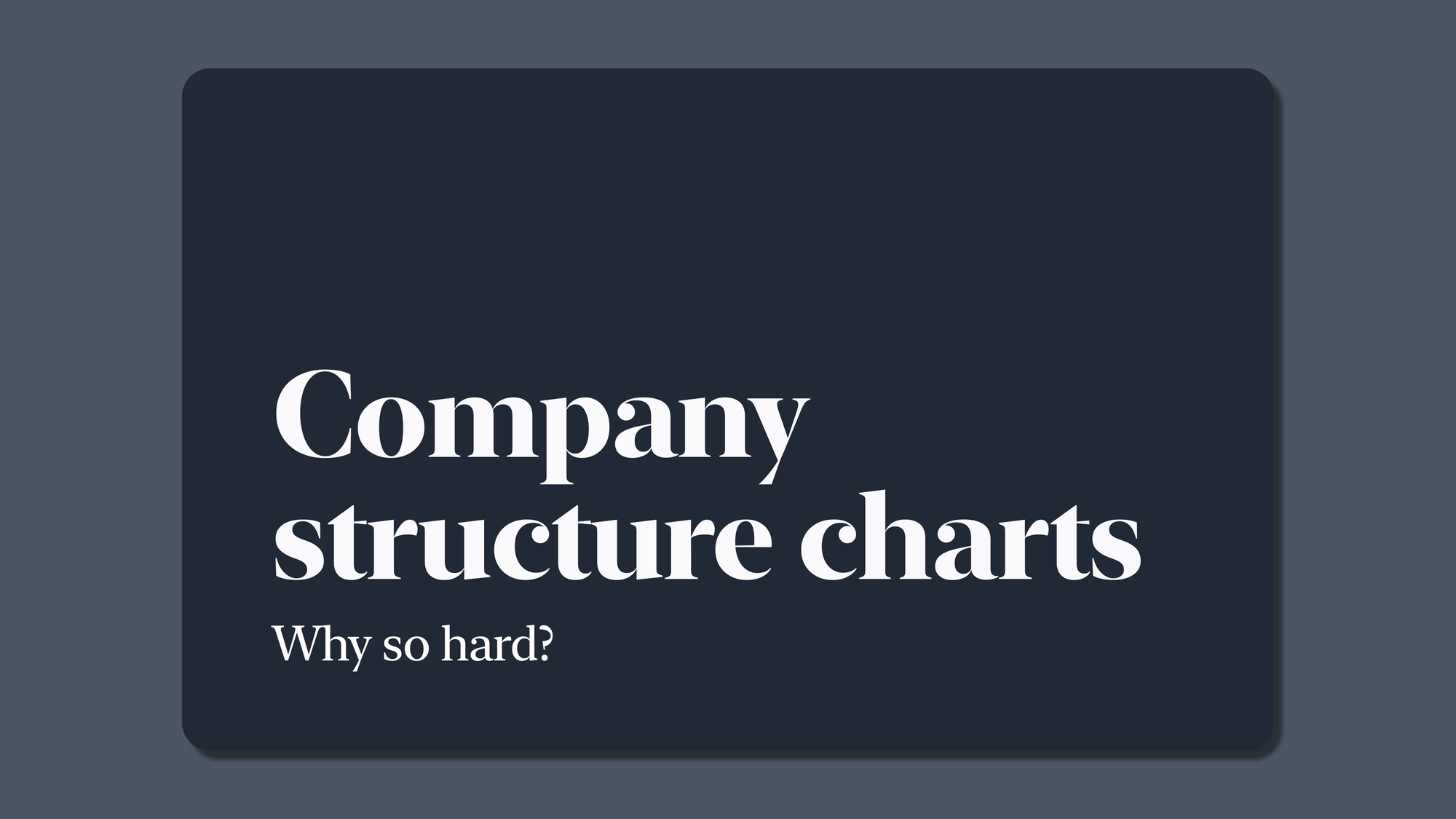Why are company structure charts so hard?

Ownership, Management, Governance
A company structure chart is a visualization of the ownership, management, and governance relationships among legal entities, including natural persons.
Company structure charts are critical for mergers and acquisitions, due diligence, and compliance.
But why are they difficult to create?
3 Reasons
These charts are complicated by three factors:
- They must be hierarchical with some complicating exceptions,
- They can be arbitrarily large with thousands of entities and even more connections, and
- The information about entities and connections is multi-faceted.
Building blocks
Company structure charts or hierarchy charts derive from just two building blocks: cards and links.
You can create an enterprise with cards and links.
A card represents a legal entity in most cases. A legal entity is any natural person or organization recognized by a jurisdiction.
A link is the line that connects two cards. The line can represent many types of connections:
- Financial interest,
- Voting interest,
- Potential investment,
- Date of acquisition, and
- more.
Combine cards and links to create a company structure chart.
Hierarchy
Company structure charts must be hierarchical with clear levels or "generations".
These four legal entities have no connection, no hierarchy. This is a collection with two individuals, a corporation and a limited liability company.
Now there are two hierarchies. Ira Investor owns Capital Source; Frank Founder owns Great NewCo. Both connections are proximate.
Capital Source makes an investment in Great NewCo, creating a new structure. Capital Source is an immediate parent of Great NewCo, like Frank Founder.
A direct connection in a hierarchy diagram means that one card is above another. A parent company appears above subsidiaries. Individual investors appear above the startup. Limited partners are above the limited partnership.
A direct connection is proximate, which means a parent company is immediately above a subsidiary. We consider each pair of entities and their connection in isolation.
The hierarchy can have an unlimited number of pairwise links. Any single link is simple: a connection between two entities. A collection of many links can illustrate a complex and varied structure.
Each layer of the hierarchy is distinct. To read a hierarchy chart start at the top and end at the bottom.
Special cases
There are exceptions in company structure charts. To be precise, they are not exceptions. They are special cases which must be visible in the hierarchy without destroying the visual structure.
These special cases are generation skips and connection loops. Generation skipping and connections loops complicate company structure charts beyond traditional organization charts.
Skips
Ownership connections can skip generations, where an entity owns another directly and indirectly through an interstitial entity.
Here are two direct links creating a three-level hierarchy.
Frank Founder owns Great NewCo; Great NewCo owns Fast Distribution. There is a pair of direct links which create this hierarchy. Frank is an indirect owner of Fast Distribution.
Frank now owns half of Fast Distribution directly. Great NewCo owns the other half.
Since Frank directly owns Great NewCo, he must appear higher in the structure. The line for his direct ownership stake skips the generation where Great NewCo is.
The link can skip any number of generations.
Loops
Charts can contain "circuits," a feature from graph theory in mathematics. An entity on a lower level can have a connection to another entity higher up in the corporate structure. That connection could represent ownership, financing, management, or governance.
Here is a structure with no loops or circuits. Notice how Finance Co. is on the bottom generational level.
If Finance Co. provides financing to Capital Source, then it has a hierarchical relationship with Capital Source. This creates a loop or circuit.
Notice the levels remain the same. The "higher" entity, Finance Co. has a line starting down, but then it loops up to enter the top of Capital Source.
These consistent paths — lines start at the bottom and enter the top — improve chart readability.
If Finance Co. finances Affiliate Co. instead, there is no loop because Affiliate Co. has no direct hierarchical link to Finance Co.
Large
Company structure requires an infinite canvas which presentation software, like PowerPoint, cannot provide.
The legal structure of a business spans thousands of corporations, limited liability companies, partnerships, trusts, and individuals across any number of jurisdictions. Here are only 100.
A mere 102 links for 100 legal entities creates a large company structure chart. Imagine hundreds or thousands of connections per entity, a not uncommon situation based on 20 years of working with thousands of companies across 6 continents.
The combinations of connections make manual design applications, like Visio, impractical for company structure charts.
Faceted
The line is the point.
The link between two cards can have many facets: ownership, control, management, financing, and aspects of each.
The ownership and investment relationships among legal entities create an elaborate structure. Those connections are data-driven.
Each of these nine cards has attributes describing itself in more detail.
These entities come from Switzerland, Mexico, Japan, and Singapore. They share the same attributes of legal entity type, jurisdiction, units (of ownership), local name, and currency.
The Swiss legal entity, however, does not show a tax status, while the rest do.
These cards have some nexus with the United States. The blue cards are legal entities formed or created in a jurisdiction as a legal entity type with a tax status.
The green cards are individuals with a citizenship and a residence.
Each card displays an important variation in the data about itself.
The Evans Family Trust has two types, Trust and Grantor, to show what kind of trust it is.
Frank Founder has a Title, President & CEO, while Ira Investor has a subtype, Accredited Investor.
These facets convey important legal and financial information to people reviewing a chart.
Links have facets too. A single link displays information about itself. Ira owns one million shares of Capital Source and has 100% voting control.
Links can also display changes over time.
Frank Founder owns 100 membership units of Great NewCo with 100% of the financial interests and voting control. Frank considers selling part of the business to Capital Source, leaving him with 55% of the voting control.
Capital Source would contribute five million dollars for various ownership interests and veto rights.
The facets of each link are important for anyone trying to understand the potential investment.
Company structure charts simplified
Legal and finance professionals create company structure charts every day. These large, hierarchical charts need an infinite canvas with support for unlimited entities and links between entities.
Lexchart creates company structure charts automatically. The intelligence in Lexchart lays out the hierarchical structure of even the most complex enterprise. Lexchart is data-driven. Your data – entities and connections – creates millions of possible layouts. Lexchart creates those layouts, then selects an optimal design.
Principles: 5 keys to automatic organization charts
There are 5 principles for automatic organization charts:
- Create a vertical hierarchy
- Reduce line crossing
- Straighten lines when possible
- Handle exceptions: skips and loops
- Render the entire chart in less than 1 second
Lexchart places cards on the correct vertical level of the hierarchy. It consider the entire structure and all branches when placing an entity on a generational level. The hierarchy should start at the top and end at the bottom.
Horizontal position of cards begins with grouping branches together. Notice the branch of green cards rendered together on the right.
Lines are straightened when possible. Notice the red line spans four layers of the hierarchy to reach the fifth. Even so, Lexchart places the cards horizontally so that this line is straight.
With curved lines enabled, it is clear that Lexchart designed a chart with 100 companies and over 100 connections without a single line crossing another line.
Lexchart handles generation skipping and looped connections with ease. Lexchart renders a company organization chart in less than a second.
Alternatives
To place that feat in context, legacy org chart software relies on either:
- Manually pushing boxes around on a fixed canvas, or
- Simplistic single level hierarchies.
The intelligence in Lexchart evaluates all cards and links regardless of number.
The algorithms and heuristics lay out the entire chart on an infinite canvas. Lexchart designs the structure considering optimal horizontal and vertical placement of cards, links, and entire branches.
Among millions of combinations, Lexchart automatically finds the optimal layout or handful of layouts.
Professionals: Who uses Lexchart?
Legal, finance and business professionals use Lexchart in:
- Private equity,
- Family offices,
- Multinational corporations,
- Law firms,
- Investment banks,
- Banks and financial services, and
- Companies of all sizes.
Purpose: When to use Lexchart?
These professionals use Lexchart to build:
- Ownership charts that illustrate the financial and voting control of a company structure;
- Management charts that show the reporting relationships among employees of a company; and
- Governance charts that display the board of directors and committees which oversee a company.
Some people use Lexchart to find an ultimate business owner (UBO) for compliance purposes or to satisfy due diligence requests.
Lexchart creates company structure charts automatically.
Lexchart is built by and for legal and finance professionals to visualize and explain complex structures simply.

